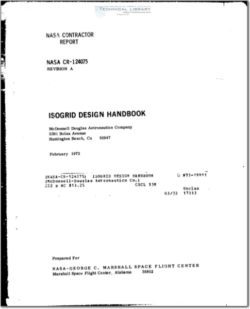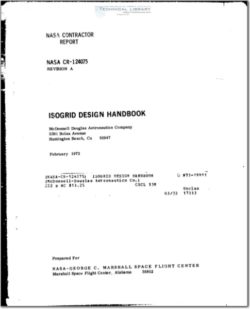NASA-CR-124075

- Version
- 316 Downloads
- 8.21 MB File Size
- 1 File Count
- November 27, 2015 Create Date
- November 27, 2015 Last Updated
Isogrid Design Handbook

FOREWORD
This program, the development of the isogrid design handbook, was
conducted by the McDonnell Douglas Astronautics Company at Huntington
Beach, California under NASA Contract NAS 8—28619. The contract was
administered under the direction of John Key, Marshall Space Flight Center,
NASA.
The McDonnell Douglas program was conducted under the direction of l
Dr. George Moe, Director, Research and Development, with M. B. Harmon
acting as principal investigator. Dr. Robert R. Meyer was the principal
contributor to this document, being responsible for Sections 2 and 4, basic
theory and analytical techniques. Other major contributors include 1
Mr. O. P. Harwood and Mr. J. 1. Orlando.
The information in the document was obtained from: (1) the results of
analysis, test, and advanced manufacturing studies of Independent Research
and Development programs, (2) a phase B space shuttle booster study funded
by the NASA Marshall Space Flight Center, (3) an isogrid tank test program
funded by the NASA Marshall Space Flight Center, and (4) the Delta program
isogrid structural tests funded by the NASA Goddard Space Flight Center.
Appreciation is expressed to Mr. Jack Furman of the NASA Marshall Space.
Flight Center for his continued interest in the development. and application of
isogrid to aerospace structures.
1.1 BACKGROUND
The establishment of new, lightweight, economical, and efficient structural
concepts for aerospace structures has long been an objective of NASA and
the industry.
Lightweight, compression—load-carrying structures form part of all air-
craft, booster, and space vehicle structures. Aircraft such as the DC-~6 or
DC—7 used mechanically attached stringer, frame, and skin construction,
which are of course 9'.)-degree stiffened structures. Boosters, however,
were designed as integrally stiffened structures because of leakage con-
siderations. In the ’Saturn vehicle, the 8-11 second stage duplicated aircraft
0- to 90-degree patterns with an integral, constant-height machined pattern.
The S-IVB stage, as well as the Thor, used square patterns rotated through
45 degrees.
The 0— to 90—degree and 45-degree stiffening patterns used in the stages of
the Saturn vehicle are extremely efficient in Certain load regimes. However,
they are inherently four bar lanS prevented from collapsing by the integral
skin and as a result have little in—plane torsional resistance capability.
In 1964, Dr. Robert R. Meyer under a NASA-MSFC contract, Reference l—l,
set out to find the optimum stiffening pattern for compressively loaded
domes. A goal was to find a structural arrangement that negated the short-
comings o.‘ the 0- to 90—degree and 45—degree patterns without introducing
other penalties such as increased Weight. The concept that was found to be
the most promising was triangulation of the stiffening members. This
pattern took advantage of the simple fact that triangular trusses are very
efficient structure. This work showed significant promise and was extended
to cylinders as an Independent Research and Development program.
| File | Action |
|---|---|
| NASA-CR-124075-Isogrid-Design-Handbook.pdf | Download |

Comment On This Post